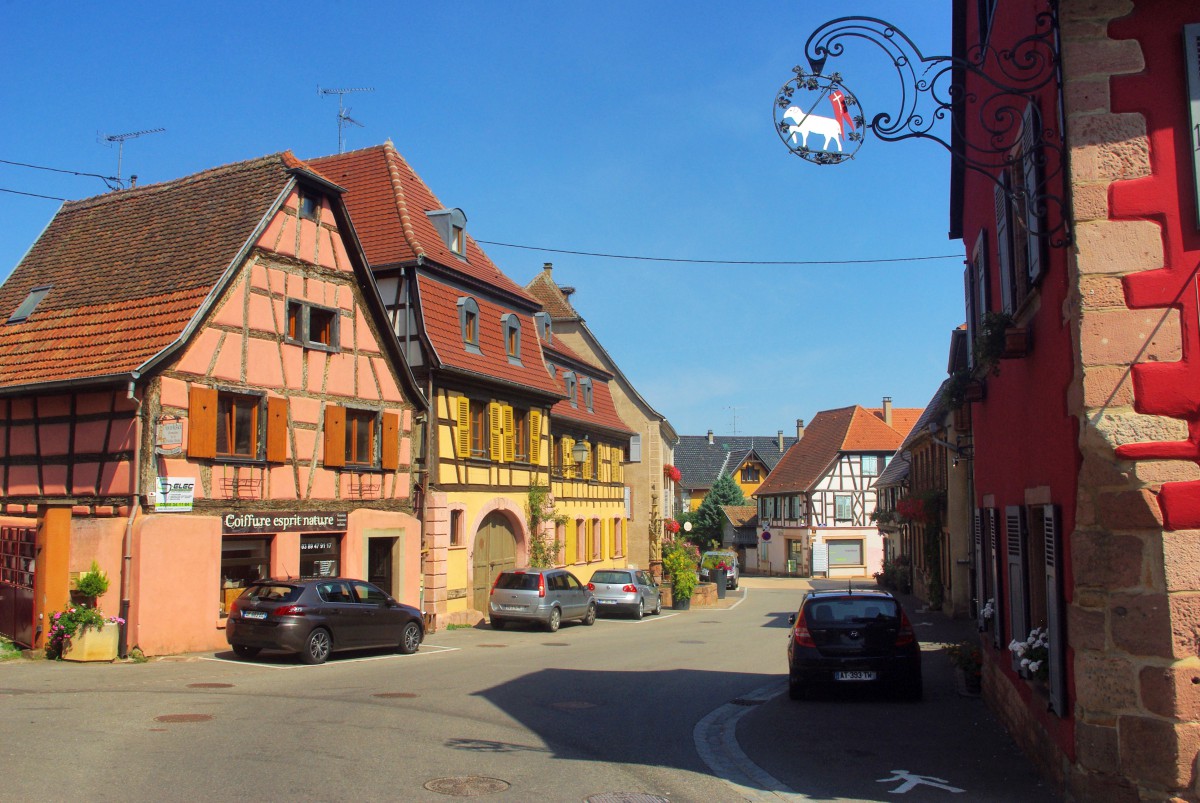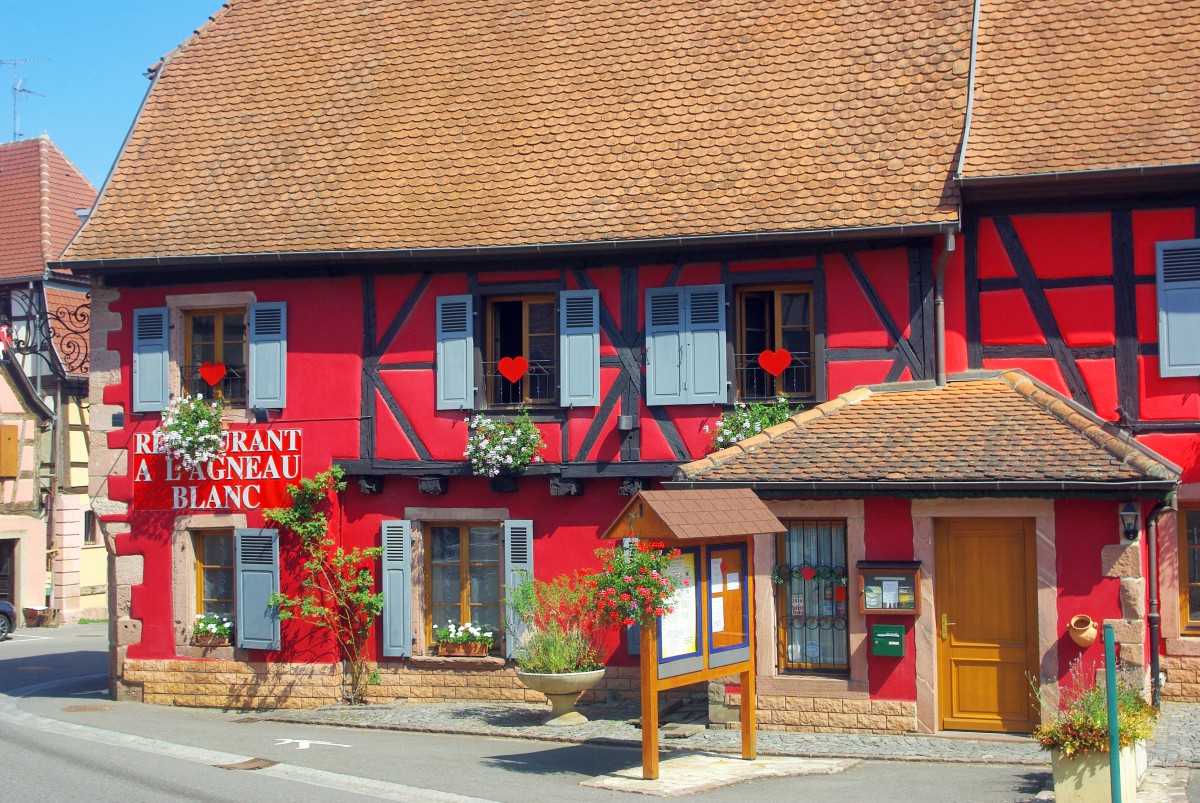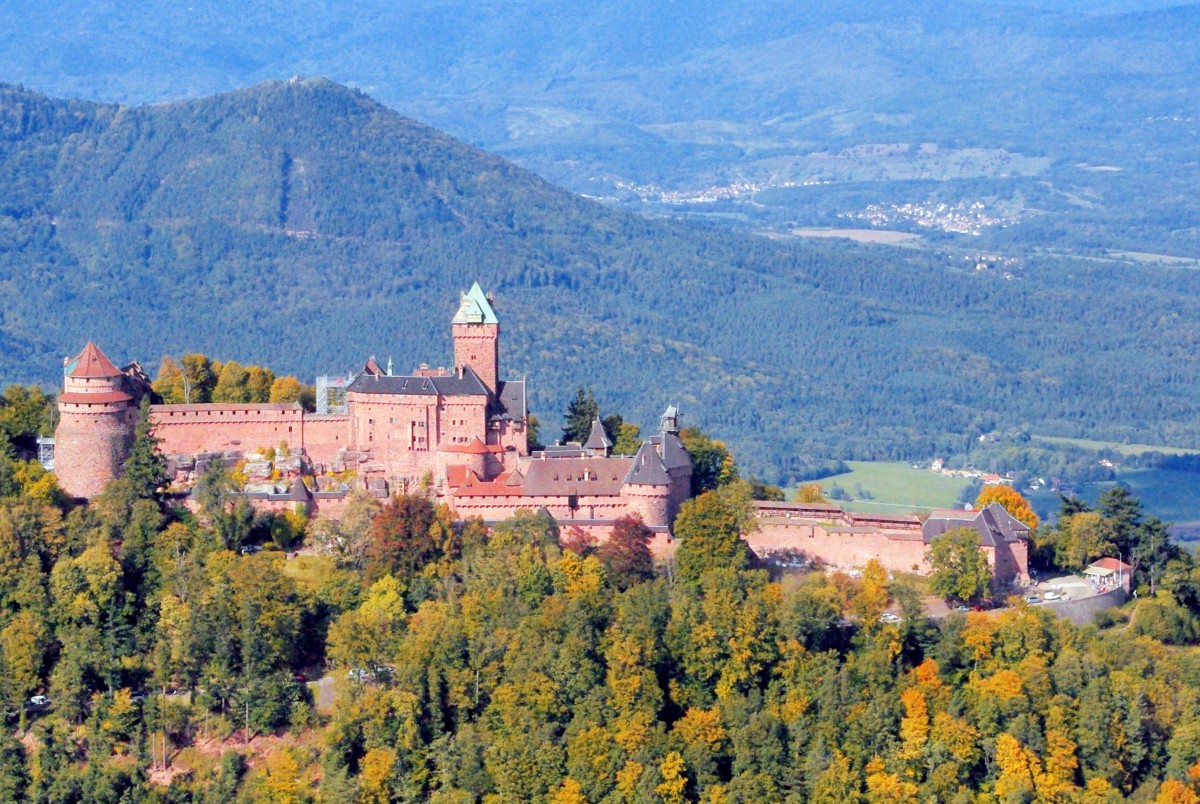Beblenheim is a charming village situated not far from Riquewihr.
A little away from the tourist sites of the Alsace Wine Route, Beblenheim appears to be an ideal destination to spend an hour or two in a typical Alsatian wine village.
On a warm Summer day, my first visit to Beblenheim was full of surprises with flower-decked half-timbered houses emerging from the vineyards.
Beblenheim: a little presentation

Situated at 215 m high, the village of Beblenheim lies in the shade of a hill covered with vines: the Sonnenglanz (in Alsatian dialect: the bright sunshine).
Home to a little less than 1,000 people, the village is made up of many half-timbered houses.
Most of them date back to the 18th and 19th centuries. Approximately 20 houses were built as far as the 16th and 17th centuries.
By observing this peaceful village, who would have guessed that about 90 per cent of the traditional homes were destroyed during the terrible fights of the Pocket of Colmar in December 1944.
Today, the rebuilt village looks like a picture postcard of this lovable region of Alsace…
The vineyards of Beblenheim are world-renowned for their great wines: pinot gris, muscat, riesling and gewurztraminer.
The sunny hillside of the Sonnenglanz makes a Grand Cru (of the same name) and a second wine named Schloesselreben.
A little discovery circuit of Beblenheim
Ideally, park your car on one of the few car park spaces situated around the protestant church (rue Chrétien Pfister or rue de la vieille école).
Rue Chrétien Pfister

Walk along rue Chrétien Pfister. At number 4 stands the house of Chrétien Pfister.
Born in 1857, Pfister was a senior lecturer at the Sorbonne, Paris, in 1904 and dean at the Faculty of Arts in Strasbourg.
Turn right onto rue de Zellenberg.
Facing you is the St. Martin catholic church.
Rue Saint-Martin

Turn right onto rue Saint-Martin to come back to the village centre.
You will pass by very fine half-timbered houses with brightly-coloured façades.
Rue de Hoen
The Town-Hall building (2 rue de Hoen) was built between 1838 and 1840.

Walk on rue de Hoen. To the left, in front of a yellow half-timbered house, is the St. Nicolas fountain or “Stockbrunnen”.

The Gothic-style fountain in yellow sandstone dates back to the 16th century.
It was magnificently decorated with statues, flowerets and pilasters, signs of the village’s wealth.
The depictions of Saints (Anthony, John and Nicholas) were deformed during the French Revolution.
At number 14 of rue de Hoen looms the former castle at the rear of an inner courtyard.

The domain was the possession of the Hoen of Dillenburg family from 1605 to 1938 (hence the street’s name).
Today, it houses a wine-growing cooperative (site of the Heimberger cellar).
Rue Stutz
Turn right onto rue Stutz.
The street leads to a quiet little square whose centre is occupied by a flower-decked fountain in Summer.

Continue on your way, and to your left (at number 8), you’ll notice a strange little half-timbered house not quite straight.
It is locally known as “Krumm” (which means in dialect: askew).

Take the right onto a small pathway called “Misspfad“.
It will lead you across gardens and orchards.
The lane follows the bed of an old stream that used to serve the village with water.
It emerges on rue Jean Macé.
Rue Jean Macé

Rue Jean Macé is particularly beautiful during the Summer and Autumn seasons when the flower display reaches its height.
The street takes its name from a Republican exiled from Paris under the reign of Napoleon III.
Jean Macé (1815-1894) lived in Beblenheim and taught at the village’s boarding school for young girls.
The Chrétien Oberlin monument and the Protestant temple
Reach the rue de Hoen and turn left.
Climb the stairs that lead to the front door of the protestant church to enjoy a view of the village’s old half-timbered houses.

To the left stands a monolith is sandstone.
The Chrétien Oberlin monument evokes the memory of the mayor of Beblenheim from 1870 to 1902.
This pioneer of the Alsatian vine succeeded in overcoming the phylloxera disaster.
He is credited with the system of vine culture by a palisade with wires, still used in Alsace.

Notice the 8 tomb slabs fixed onto the wall separating the church from the presbytery.
They are dedicated to the notables of the village.
The legend of Noah in Beblenheim

Legend has it that the origins of Beblenheim trace back to the Biblical times of Noah.
Many thought the ark and its animals landed on Mount Ararat.
Nothing could be more untrue, according to the local archives!
Because we know that Noah liked good wine… and there were no vines in the Caucasus.
Legend has it that the arch stopped on the Sonnenglanz, the vine-covered hill on which the foot of Beblenheim was built.
The end journey of the big boat was celebrated, as required, with the best wines of the region.
Following this, the Patriarch baptised the site “Noah’s Gate”, which is said in Aramaic “Bab el Noem“.
Over time, the name became “Beb-len-heim”. Quite obvious, isn’t it? (Read the story in French here)
To find out more about Beblenheim
- Beblenheim is on the site of the Tourist Office of Ribeauvillé-Riquewihr.
- Download the village map and the discovery brochure.
- The village is situated 3km from Riquewihr, 10km from Colmar and 20km from Sélestat.
More photos taken during the last visit to Beblenheim:













Continue the visit in the region…
Beblenheim is situated in the centre of a wine region which boasts some of Alsace’s most beautiful villages and sites:
Ribeauvillé and its three castles

The fortified village of Bergheim

The perched castle of the Haut-Kœnigsbourg

The old town of Sélestat

The fortified church of Hunawihr

Riquewihr, the gem of the Alsatian vineyards

The town of Kaysersberg, the French’s favourite village in 2017

The old town of Colmar and its Little Venice district

and of course the famous Alsace Wine Route!

Did you like what you read? If so, share it on Facebook or X!
Pin it for later:





